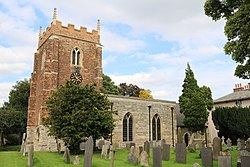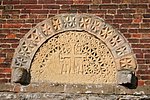Hawksworth, Nottinghamshire
| Hawksworth | |
| Nottinghamshire | |
|---|---|
 Church of St Mary and All Saints, Hawksworth | |
| Location | |
| Grid reference: | SK752434 |
| Location: | 52°58’48"N, -0°52’48"W |
| Data | |
| Population: | 122 (2011) |
| Post town: | Nottingham |
| Postcode: | NG13 |
| Dialling code: | 01949 |
| Local Government | |
| Council: | Rushcliffe |
| Parliamentary constituency: |
Newark |
Hawksworth is a village in Nottinghamshire, in the south-east of the county, ten miles south of Newark-on-Trent and adjacent to the villages of Flintham, Sibthorpe, Thoroton, Scarrington and Screveton.
The 2011 census recorded a population of 122.
Name
The name 'Hawksworth' seems to contain an Old English personal name, Hoc, with the suffix weorð, an enclosure, so "Hoc's enclosure".[1][2] Later the first element was altered through the influence of the Old Norse haukr , a hawk.[3]
Hawksworth appears in the Domesday Book of 1086 as Hochesuorde and Huchesworde.[4]
History
The village is mentioned twice in the Domesday Book[5] with a taxable value in total of 1.7 geld units.
Enclosure of common land took place in 1761.[6] Part of Hawksworth has been a conservation area since February 2010.
White's Directory of Nottinghamshire, written in 1853, describes Hawksworth:[7]
Hawkesworth, anciently called Hocheword, is a small village parish 4 miles north-east of Bingham, and 8 miles south-south-west of Newark. It was of the fee of Walter D'Ayncourt, and partly soc to Aslacton. It now contains 171 inhabitants, and about 800 acres of land, most of which belongs to the Rev. John Storer M.A., who is lord of the manor. Mrs Hunt is the patron of the rectory, which is valued in the King's books at £8 13s 9d, now £268, and is in the incumbency of the Rev. George Hunt Smyttan B.A. At the enclosure (in 1761), 143 acres were allotted in lieu of tithes. The church, dedicated to St Mary and All Saints, is a small building, with a brick tower. The chancel has been lately rebuilt, and contains some fine stained glass by Wailes of Newcastle.
John Throsby, writing during 1790 in his new edition of Robert Thoroton's Antiquities of Nottinghamshire, describes Hawksworth as:[8]
LORDSHIP is small, owned by — Turner, Esq. The village and the church also, are inferior places: the latter is dedicated to St. Mary and All Saints, and has a brick tower.
Parish church

The parish church, the Church of St Mary and All Saints, is Norman in origin, with an elaborate tympanum, but it was almost completely rebuilt in a 19th century restoration. It is a Grade II* listed building.[9]
The church contains a large portion of an Anglo-Saxon Cross, which is believed to date back to the late 9th or early 10th century.[10]
The Norman tympanum, believed to date to the 12th century, is made of sandstone and is surrounded by a semi-circular ornamental stone arch.[11] The tympanum marks the founding of the church in Hawksworth, with the (translated) Latin inscription reading "Walter and his wife Cecelina caused this church to be made in honour of Our Lord and of Saint Mary the Virgin and of all God's Saints likewise".[11]
The rebuilding of the church took place in 1812–1813 (nave), 1837 (north aisle) and 1851 (chancel). In 1866 the west porch was demolished and the tympanum, which had been positioned above the porch entrance, was moved to its present position on the south exterior face of the tower.[11] The brick tower dates from the 17th century.[12]
About the village
The village has five other Grade II buildings, all in Town Street: Boundary Walls at Top Farm; Hawksworth Manor House and adjoining pigeoncote; Hawksworth Place (the former rectory) and adjoining walls; model farm buildings at Top Farm; and Yew Tree Farm and adjoining wall.
The National School, which is now a private house, was built in 1844. The Wesleyan chapel, now also a private house, was built in 1883. Until 1987 the former chapel was used as the village hall.
W. B. Stubbs Progress Works was founded in 1836 by a local blacksmith. Today's W. B. Stubbs (Hawksworth) Ltd makes a variety of equipment for stables.[13]
Pictures
-
The Church of St Mary and All Saints in Hawksworth
-
The clock face on the Church of St Mary and All Saints in Hawksworth
-
A road to Hawksworth
-
A grass triangle at the centre of Hawksworth
Outside links
| ("Wikimedia Commons" has material about Hawksworth, Nottinghamshire) |
- The Southwell & Nottingham Church History Project article on the Church of St Mary and All Saints
- History of Hawksworth: Notts Villages
References
- ↑ Mills, Anthony David: 'A Dictionary of British Place-Names' (Oxford University Press, 2003) ISBN 978-0-19-852758-9
- ↑ Ekwall, Eilert, The Concise Oxford Dictionary of English Place-Names. Oxford, Oxford University Press, 4th edition, 1960. p. 227 ISBN 0198691033
- ↑ Gover, J. E. B.; Mawer, A. & Stenton, F.M.: 'Place-Names of Nottinghamshire , Part' (English Place-Names Society, 1940), page 226
- ↑ National Archives: E31/2/2/3907
- ↑ Hawksworth, Nottinghamshire in the Domesday Book
- ↑ Conservation Area Report: Hawksworth
- ↑ Information on Hawksworth, Nottinghamshire from GENUKI
- ↑ Parishes: Hawkesworth (Thoroton's Antiquities of Nottinghamshire), on British History Online
- ↑ National Heritage List : Church of St Mary and All Saints, Hawksworth
- ↑ Nikolaus Pevsner: The Buildings of England: Nottinghamshire, 1951; 1979 Penguin Books ISBN 978-0-300-09636-1
- ↑ 11.0 11.1 11.2 Hawksworth – Archaeology: Southwell Churches
- ↑ Corpus of Romanesque Architecture
- ↑ "Company Details" (in en). http://www.stubbsengland.com/index.php?route=information/contact.




